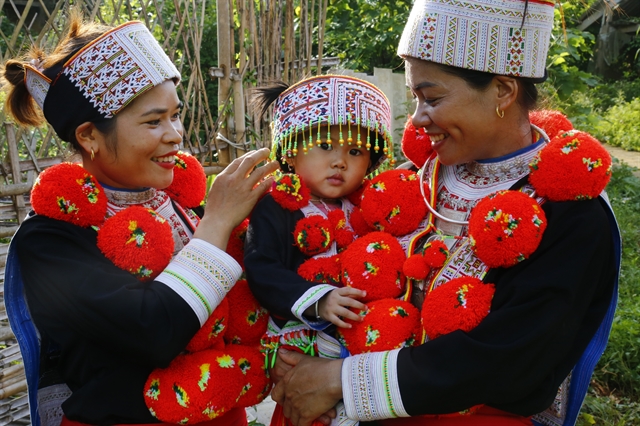Weather:
- Ha Noi 23oC
- Da Nang 21oC
- Ho Chi Minh 33oC

The Dao people are an ethnic minority group in Việt Nam, consisting of seven subgroups, of which the Dao Tiền are renowned for their cloth printing technique with beeswax and indigo. Nguyễn Anh Cường, deputy head of the Faculty of Tourism Management and International Languages at Hà Nội University of Culture, talked with Việt Nam News reporter Lê Việt Dũng about the patterns on the Dao clothes.
Formerly Cường was head of the Faculty of Ethnic Minority Culture at the university and a researcher at the Institute of Anthropology. He is also the co-author of the book Traditional Costumes of the Dao People in Vietnam.
Inner Sanctum: What is the significance of the patterns on Dao costumes?
Costumes are a fundamental element of an ethnic group's identity, culturally setting it apart from others. Fabric patterns are more than just decorative; they hold deep historical and cultural significance.
The Dao use a variety of symbolic patterns, such as sun motifs, tree patterns, bird patterns, and human figures. One common pattern among most Dao subgroups is the dog pattern, linked to their ancestral legends. This pattern is prominently featured on the groom's attire in Dao Tiền weddings.
Beyond their symbolic meaning, the patterns on Dao costumes also reveal clues about their migration history. For instance, some costumes may feature sheep motifs (called glù) alongside the more common ones. Sheep are associated with nomadic herders, suggesting that some Dao communities may have previously lived in grassland areas before moving to the mountains.
Inner Sanctum: What is the significance of the Bàn Vương insignia?
According to Dao legend, a five-coloured dragon dog descended from the heavens and was raised in the palace of King Bình Vương. One day, a conflict arose between Bình Vương's kingdom and Cao Vương's. The dragon dog sought Bình Vương's permission to join Cao Vương's side in hopes of finding an opportunity to kill him. Bình Vương agreed, promising the dragon dog the princess's hand in marriage if he succeeded.
When Cao Vương saw the dragon dog prostrating himself in front of the courtyard, he believed it was a good omen and took it home. One day, while Cao Vương was hosting a feast and was intoxicated, the dragon dog bit him to death and took his head back to Bình Vương. The dragon dog then transformed into a human and married the princess, and was called Bàn Vương.
As Bàn Vương's descendants multiplied, the land became overcrowded. Bàn Vương then allowed them to explore and settle in new lands. During this process, they embroidered a symbol called the Bàn Vương insignia on the backs of their shirts so that anyone who saw it would know they were descendants of Bàn Vương and had his permission to explore new territories.
Today, all Dao costumes have the Bàn Vương insignia embroidered on the back. However, each Dao subgroup has a different variation of the pattern. For example, the Dao Quần Chẹt have a large rectangular pattern on the back, while the Dao Quần Trắng embroider a smaller one.
Inner Sanctum: What are the similarities between Dao patterns and other ethnic groups' patterns?
Certain Dao patterns exhibit similarities to those found in ethnic Mông culture. The similarities stem from the fact that both groups inhabit mountainous regions at elevations ranging from 800m to 1,500m.
These common patterns often depict elements of their shared environment, such as pine trees, mountain ranges, rivers, streams, birds, and deer.
Inner Sanctum: Do the Dao have any taboos or customs during the process of making clothes?
The Dao adhere to a set of customs and taboos during the process of making their garments. These practices reflect their deep-rooted beliefs and traditions.
For instance, places where indigo dye is prepared are considered off-limits to strangers, pregnant women, and even pregnant animals. Their presence is believed to disrupt the dyeing process, causing the indigo to clump and the dye batch to be ruined.
The patterns and colours adorning Dao costumes are limited to a palette of five colours - white, yellow, green, purple, and red. These colours are associated with the five colours of the Dao's ancestral dragon dog.

The Dao Đỏ traditionally do not weave their fabric but instead purchase it from other groups to make their clothing. According to legend, a Dao Đỏ girl once met a tragic end while weaving, being struck in the head by a wooden beam. This incident prompted the Dao Đỏ to establish a custom prohibiting their girls from weaving and instead requiring them to buy fabrics from other groups for their garments.
Dao Thanh Y women traditionally wear short pants, a practice rooted in another legend. In the past, Dao Thanh Y women wore long pants. However, a Dao Thanh Y girl accidentally spilled a bowl of medicine while cooking it for her sick mother-in-law due to her long pants getting in the way. Unable to retrieve the medicine in time, her mother-in-law passed away. Filled with remorse, the girl cut off the legs of her pants. This incident led to the Dao Thanh Y custom of women wearing short pants for convenience in daily activities.
Inner Sanctum: How have traditional Dao clothes changed over time?
In the past, Dao women typically wore four-panel shirt. However, some women have now opted for simpler blouses while retaining the traditional skirt.
The band of cloth worn around the legs was once a common element in Dao clothing. However, its usage has gradually declined over the years.
Dao Tiền women were known for their elaborate silver jewellery, often adorning their heads, necks, fingers, ears, and more with pieces weighing up to three kilograms. This practice has become less common, with most women now wearing only a few simple pieces. VNS


